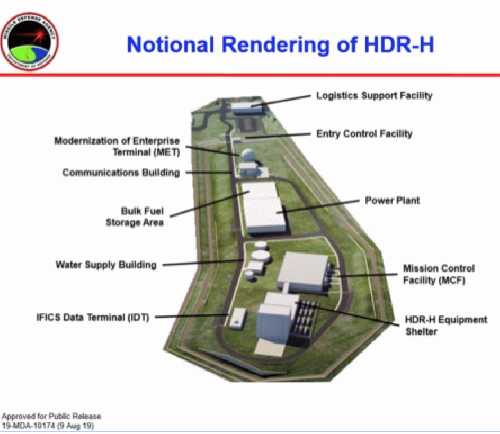The US Missile Defense Agency (MDA) announced in 2018 that it was planning to build a two-billion-dollar radar system called the Homeland Defense Radar Hawaii (HDRH) on Oahu, Hawaii. The 2017 National Defense Authorization Act required the MDA to develop and field a "discrimination radar" to improve the defense of Hawaii from ballistic missile threats. "Discrimination" refers to the ability to distinguish actual warheads from rocket debris, countermeasures and decoys, which, according to the Union of Concerned Scientists (UCS), such radar systems are not capable of doing and have never been tested for under real life scenarios.
A preliminary Environmental Impact Study (EIS) named two possible locations on Oahu for the 8-story-tall-by-8-story-wide radar station that would take up approximately 160-acres of land, both of which have sites of cultural significance, native temples or heiau sacred to native Hawaiians. In June 2018 the MDA held public meetings to invite members of the community to participate in the scoping process in order to prepare a final EIS which was supposed to be completed in 2020. Sparky Rodrigues, a Native Hawaiian activist and founding member of indigenous environmental activist group, MÄ �lama MÄ �kua, was present at a public meeting. According to Sparky:
"The USA military continues the attack and invasion of Hawaii. Another state sanctioned abuse of conservation lands and sacred cultural sites. Desecration of Hawaii national treasures destroyed forever."
MÄ �lama MÄ �kua adopted and published a resolution opposing the HDR-H in July, 2018.
I became aware of the HDRH project in 2019 when it was announced that Lockheed Martin won the contract to build the radar. I wrote an article about it as an GN analyst that was published in November in Op-ED news. I was then invited to give talks on the radar system by Dr. Lynette Cruz of MÄ �lama MÄ �kua in Oahu and in Wai'anae, near one of the proposed locations, with Helen Jaccard of the Veteran's for Peace Golden Rule, the anti-nuclear peace boat. The opposition from the mostly indigenous community was fierce. It was streamed live on Facebook. I also attended several Neighborhood Board community meetings where the MDA team put on a pitch for the HDRH. The local community wasn't buying it. The opposition was loud and clear. In December 2019, the MDA granted cultural practitioners from MÄ �lama MÄ �kua access to one of the proposed sites to visit the heiau and conduct ceremonies. Witnesses told me that MDA officials present were brought to tears witnessing and participating in ceremonies of Aloha Ê �Ä ��ina or love of the land shared by the practitioners.
In January 2020 the MDA announced it was delaying the final EIS by at least a year due to "cultural challenges" by native Hawaiians. The recent actions by native Kia'i or protectors challenging the construction of the Thirty Meter Telescope on Mauna Kea certainly had the MDA concerned about future protests to HDR-H. The MDA then proposed an alternative site for the radar on the island of Kauai at the naval Pacific Missile Range Test Facility (PMRF) to try to sidestep local opposition. But in February 2020, the Pentagon's 2021 Budget proposal zeroed out funding for the HDR-H radar, indicating it was cancelled. However congressional and senate representatives from Hawaii are lobbying for the project to still be built.
In a March congressional hearing of the House Armed Services Committee, Senator Mazie Hirono from Hawaii pressed Defense Secretary Mark Esper if the decision to zero out funding in 2021 for the radar was a decision to not build the radar. Not necessarily," Esper said. "What we're trying to do is in an era of tight budgets, make sure we don't put money against something that has no possibility of being effected in the near term," he said.
According to a recent Honolulu Star-Advertiser article, delegates from Hawaii, Sens. Hirono and Brian Schatz and Reps. Ed Case and Tulsi Gabbard said in a join statement, "We will work in the authorizing and appropriating committees to keep this project funded so that MDA can continue to apply a technically sound strategy for protecting all of us."
Pentagon analysts assess that the HDRH is being replaced by a space based sensor layer currently under development by the MDA in what is a major overhaul in missile defense strategies to counter hypersonic missiles. The HDRH, like its precursor, the nearly completed Long Range Defense Radar (LRDR) in Alaska, is a midcourse tracking radar used to identify ballistic missiles early in flight to be intercepted by ground based interceptors (GMD) based in California and Alaska. But the MDA is upgrading GMD interceptors with the Next Generation Interceptor (NGI), that will take 10 years to develop and deploy, rendering the HDRH useless.
In the meantime, the MDA is developing a "layered" approach to missile defense that relies on extending the range of Aegis SM3-Block 2 interceptor while awaiting the NGI upgrade. The Aegis SM3-Block 2 interceptor was designed for short and intermediate range targets, not intercontinental-range ballistic missiles (ICBM). The MDA is planning to test the extended SM3 in Hawaii in 2020 to intercept an ICBM launched from the Kwajalein Atoll in the Marshall Islands. SM3 interceptors are cheaper than GMDs and can be deployed on Aegis navy war ships and on land in an Aegis Ashore system. Hawaii has an Aegis Ashore test system at PRMF on Kauai that the MDA wants to make operational as a defense system. Arms control experts fear that the US deploying large numbers of Aegis interceptors will compromise new Strategic Arms Reduction Treaty (START) negotiations.
Although the postponement of the HDRH seems a victory, the battle is not over. In early April the U.S. Indo-Pacific Command submitted a $20 Billion slush fund request, a Pacific Deterrence Initiative, or PDI, to bolster military presence in the Pacific, including building the HDR-H radar system. It is critical for Hawaiian and GN activists to continue to lobby Congress to stop advocating for the funding of HDRH and to oppose making Aegis Ashore operational on Kauai at PMRF. For more information about missile defense in Hawaii, please see our website: www.space4peace.org & YouTube channel: https://tinyurl.com/STOPtheHDRH






